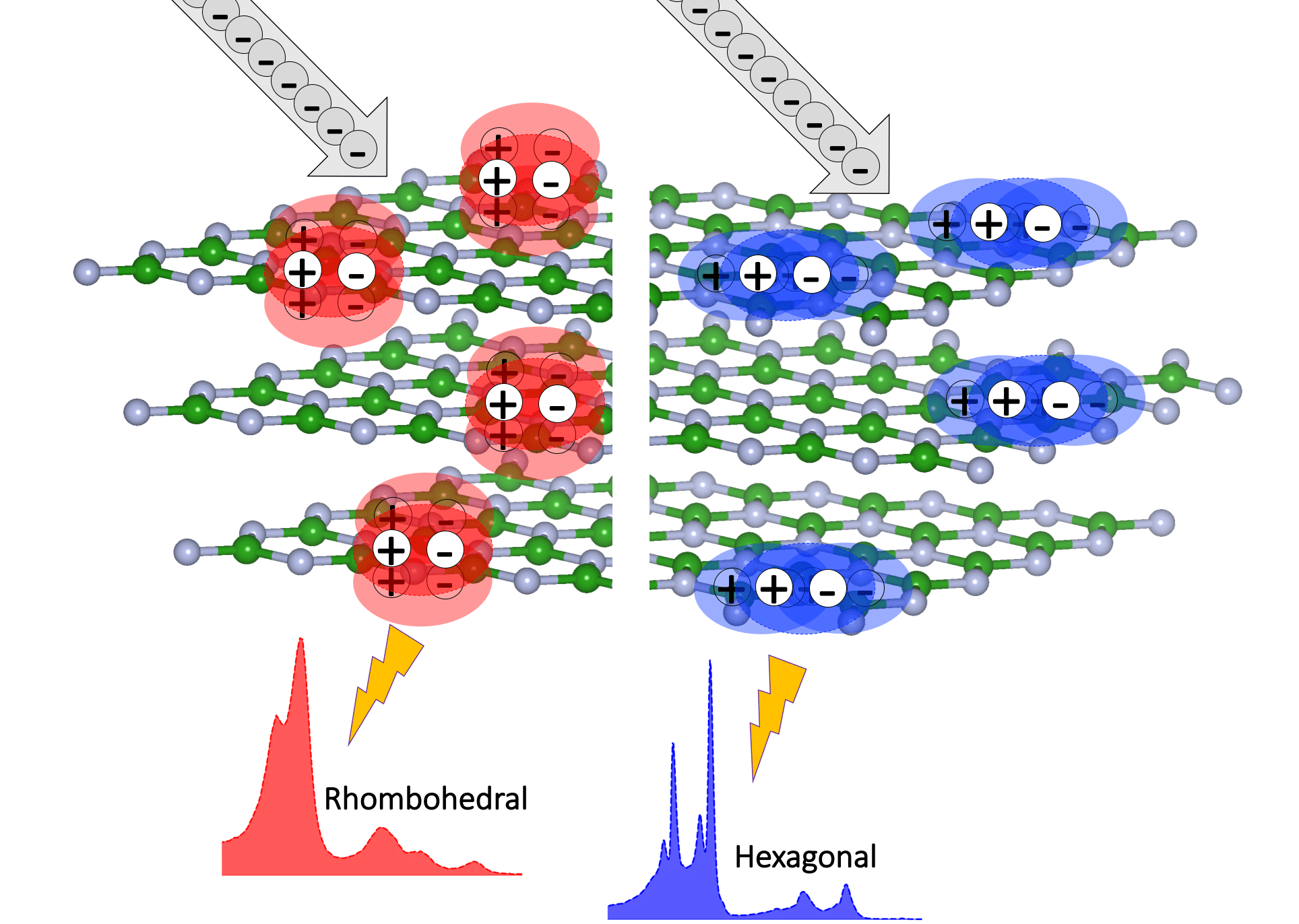
Layered materials are complex compounds composed of closely stacked atomic layers. They often exhibit polytypes, where they have the same composition but different stacking arrangements of their atomic layers, resulting in distinct crystal structures and properties. polytypes of layered materials are notoriously difficult to differentiate.
Now Researchers from the CNR Institute of Nanoscience in Modena, in collaboration with colleagues from the University Paris-Saclay demonstrated a method to discern otherwise imperceptible differences in the crystalline structure of "layered" semiconductor materials.
By meticulously analyzing the emitted light from the material—a technique known as luminescence spectroscopy—the team successfully identified variations in the crystalline structure between two similar but distinct semiconductor materials: hexagonal boron nitride and rhombohedral boron nitride. These findings have been detailed in Physical Review Letters.
"Despite being composed of the same elements, boron and nitrogen, the two forms of the material differ solely in the arrangement of their atomic layers," explains Daniele Varsano, Cnr Nano researcher and co-author of the study. "These structural disparities lead to variations in electronic and structural properties, opening doors to diverse applications—from optoelectronic devices, such as LEDs, to ceramic materials."
The researchers demonstrated that when these materials are stimulated by an electric current, the emitted light serves as a powerful tool to unequivocally differentiate between the two similar forms, effectively isolating the version with desired properties from the other one.
This achievement was made possible through a synergy of experimentation and theory. Precise measurements and analysis of the emitted light spectra from both versions of boron nitride were conducted by experimental physicists at the University Paris-Saclay. Subsequently, Cnr Nano researchers Fulvio Paleari, Daniele Varsano, Elisa Molinari, and Matteo Zanfrognini, elucidated these observed differences through theoretical simulations. "Our simulations show that the emitted light's characteristics are influenced by the distinct symmetries of the crystal lattice in hexagonal and rhombohedral forms. The dissimilarities in spectra arise from the diverse interactions between vibrating atomic nuclei and the material's electrons, prompting the emission of light," says Fulvio Paleari.
"This study demonstrates that precise measurement of emission spectra is considerably more sensitive to minimal structural differences compared to commonly used experimental techniques. This sensitivity facilitates the easy differentiation of crystalline structures when engineering new materials, ensuring greater control over the final optoelectronic properties," adds Paleari.
"From a theoretical standpoint, it underscores the pivotal role of interactions between atomic nuclei and excited electrons in layered materials", concludes Varsano. "The emission of light by a material is a quantum process involving intricate interactions among photons, electrons, and atomic nuclei constituting the crystalline structure. Our theoretical group at CNR-Nano employs advanced quantum mechanics software developed within the European Centre of Excellence MaX for theoretical material studies and the National Research Center in HPC, Big Data, and Quantum Computing ICSC. This allows us to conduct simulations encompassing all these interactions, utilizing high-performance supercomputers in collaboration with Cineca in Bologna."
Image description: Hexagonal boron nitride (right) and rhombohedral boron nitride (left). Despite their nearly indistinguishable appearances at the crystal lattice level, when struck by an electron beam, these materials produce distinct electronic excitations that interact with lattice vibrations, resulting in the emission of light with varying spectra (red/blue). These spectral differences stem from vibrations occurring solely in the rhombohedral form's vertical direction. [Image courtesy of Fulvio Paleari]
Matteo Zanfrognini, Alexandre Plaud, Ingrid Stenger, Frédéric Fossard, Lorenzo Sponza, Léonard Schué, Fulvio Paleari, Elisa Molinari, Daniele Varsano, Ludger Wirtz, François Ducastelle, Annick Loiseau, and Julien Barjon. Distinguishing Different Stackings in Layered Materials via Luminescence Spectroscopy, Phys. Rev. Lett. 131, 206902 , DOI: 10.1103/physrevlett.131.206902,
Link https://journals.aps.org/prl/abstract/10.1103/PhysRevLett.131.206902
| Cookie | Duration | Description |
|---|---|---|
| cookielawinfo-checkbox-analytics | 11 months | This cookie is set by GDPR Cookie Consent plugin. The cookie is used to store the user consent for the cookies in the category "Analytics". |
| cookielawinfo-checkbox-functional | 11 months | The cookie is set by GDPR cookie consent to record the user consent for the cookies in the category "Functional". |
| cookielawinfo-checkbox-necessary | 11 months | This cookie is set by GDPR Cookie Consent plugin. The cookies is used to store the user consent for the cookies in the category "Necessary". |
| cookielawinfo-checkbox-others | 11 months | This cookie is set by GDPR Cookie Consent plugin. The cookie is used to store the user consent for the cookies in the category "Other. |
| cookielawinfo-checkbox-performance | 11 months | This cookie is set by GDPR Cookie Consent plugin. The cookie is used to store the user consent for the cookies in the category "Performance". |
| viewed_cookie_policy | 11 months | The cookie is set by the GDPR Cookie Consent plugin and is used to store whether or not user has consented to the use of cookies. It does not store any personal data. |